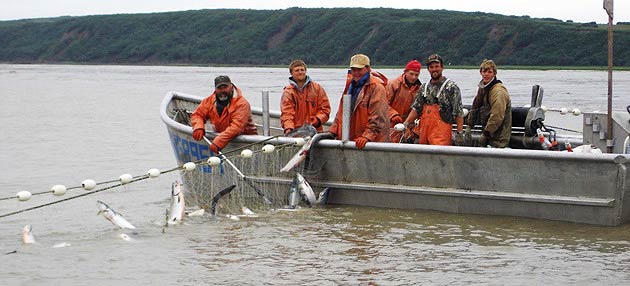The 2018 season in Alaska’s Bristol Bay was the most lucrative in the fishery’s 126 years of recorded history. Final numbers are still out for 2019, but a larger catch and higher base price mean it should top last year’s record-setting $281 million in ex-vessel value.
But despite the large harvest and the renewed threat posed by Pebble Mine, much of the post-season talk around the bay’s boatyards and bars centered around the alarming number of dead fish on the grounds. In almost all districts, fishermen reported rips and tidelines stuffed with unprecedented numbers of dead salmon, known on the grounds as ghost fish or floaters. Many fishermen reported physical reactions to the heavy volumes of putrid corpses in their nets.
“I gagged,” said Andrew Micks, a deckhand who recently graduated from the University of Washington’s fisheries program. “We got into some sets where it was every five fathoms, and it was just too much.”
Small numbers of ghost fish typically accumulate late in the season from fish dropping out of nets or being cast aside by processors, but it was clear early on this year that something different was happening.
“At first we thought it was just someone who had dumped their fish, but then they kept coming. And we heard about the die-offs in Ugashik. Then we heard a report that the water was 80 degrees in the King Salmon River and figured out it was happening here, too,” Micks said, referring to area biologists’ belief that the sockeye were swimming upriver and simply suffocating because water temperatures were so high.
“Tom Quinn did a bunch of studies down in Washington state on thermal barriers and migrations,” said Jordan Head, an Alaska Department of Fish & Game fishery biologist based in Dillingham, referencing the work of a fellow biologist. “He found that water temperatures around 70 degrees Fahrenheit would almost stop sockeye migration. And we talked with him, and he said that being so much further north, it could be a lower temperature for us. We had 24 degrees Celsius (75 degrees F) in the Igushik River this season.”
Western Alaska area management biologist Tim Sands explained that the 75 degree reading came upriver and speculated that temperatures were even warmer further downriver, adding that temperatures out in the bay hovered around 66 to 68 degrees F for much of the season.
The conundrum, of course, is why the warm water coincided with such a big run, which far surpassed the forecasts by both ADF&G and the University of Washington’s Alaska Salmon Program.
“My pet theory as to why the Nushagak has been so awesome over the last few years is because of warm winters, especially for the west side of Bristol Bay, where the lakes are a little higher elevation than east side lakes. The higher elevation lakes are a little suboptimal for growing. They (used to) freeze up in September and thaw out in May or June, and now they’re freezing up in October and thawing out in April or May; it gives us a little longer growing season,” Sands said.
That gives rearing juvenile salmon another month of growth in the lakes, which means they are bigger and slightly more competitive when they hit the ocean.
“If a female salmon lays 5,000 eggs and typically six of them come back as adult salmon, and now all of a sudden 12 of them come back, that’s all it takes. You come from average run to a record run,” Sands said.
But some fear the large die-offs seen this season mean the rivers are reaching their upper temperature limits, and could spell trouble for future runs.







